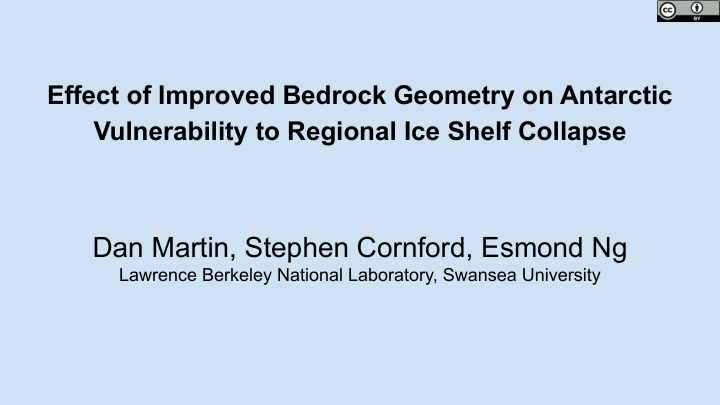



Effect of Improved Bedrock Geometry on Antarctic Vulnerability to Regional Ice Shelf Collapse Dan Martin, Stephen Cornford, Esmond Ng Lawrence Berkeley National Laboratory, Swansea University
Previous Work Martin, Cornford, and Payne, GRL 2020 ● Assessed Antarctic Ice Sheet vulnerability to regional ice shelf collapse. ○ Start with present-day AIS. ○ subject each sector in turn to extreme thinning ○ evolve for 1000 yrs using BISICLES AMR ice sheet model ● Primary AIS vulnerability is complete collapse of the submarine-grounded portion of the West Antarctic Ice Sheet (WAIS) via Marine Ice Sheet Instability (MISI) ● WAIS collapse can result from loss of any of the ice shelves (ASE, Ronne, or Ross) with a path to the vulnerable portion of the WAIS. Antarctic vulnerability to localized ice shelf collapse. ● Vulnerability elsewhere was limited and localized. Initial modeled flow speed is shown in shaded blue. Magenta lines indicate initial grounding-line locations. Mass lost above flotation (eustatic sea level equivalent, SLE) after 1000 years of extreme, sustained ice shelf thinning originating in the numbered sectors is ● Limitation -- based on Bedmap2 (2013) illustrated by the adjacent circle area. Martin, Cornford, and Payne, GRL 2020
Does Better Data Change this picture? ● Bedmap2 was the state of the art in 2013, but suffered from incomplete observational coverage and interpolation artifacts. ● Since 2013, the data has improved! ○ sustained campaign of observations, ○ improved interpolation techniques based on mass conservation. ○ Resulting datasets, including recent BedMachine dataset (2019), incorporate much-improved bedrock and thickness data compared to what was available in Bedmap2. ● Does this affect projections of vulnerability? ○ After ice-shelf buttressing is lost, the resulting Marine Ice Sheet Instability (MISI) is largely controlled by bedrock topography. ● Plan: reproduce our previous examination to examine the effect of this improvement on projected Antarctic vulnerability, ○ pay special attention to regions like the Aurora Basin which were under-constrained in Bedmap2.
Work in progress…. ● “Stuff happened” in 2020... ● Have present-day BISICLES initial condition: ○ Bedmachine (2019) ice thickness and bedrock ○ Bed friction and rheology tuned to match velocity to observations ○ Arthern accumulation field (same as before) ○ Ice temperature field from Morlighem (private communication, 2020) ● Finally getting runs going....
(very) Preliminary results ● Whole-continent ABUMIP-style experiment ○ (ABUM-style extreme shelf-thinning) ○ 1km finest resolution ○ Currently at 25 year evolution (goal is 1000 years) ● Compare with similar experiment using Bedmap2 from Cornford et al (2016) I ce thickness change for bedmachine. Magenta line is present-day grounding line.
Future (in-progress) work ● Convergence test -- verify that new bedmap doesn’t change resolution requirements for resolving Marine Ice Sheet Instability dynamics. ● Re-do regional ice shelf collapse experiment and compare to original Bedmap2 results. ● Will allow for evaluation of improved bedmap on predictions of Antarctic vulnerability to MISI and potential for future sea level rise. ○ Change in continental vulnerability? (possible that differences we see now may be due to differences in initialization rather than in the bedmap itself) ○ Change in regional vulnerability?
References S.L. Cornford, D.F.Martin, V. Lee, A.J. Payne, E.G. Ng, "Adaptive mesh refinement versus subgrid friction 1. interpolation in simulations of Antarctic ice dynamics", Annals of Glaciology, September 2016, 57 (73), doi: 10.1017/aog.2016.13 2. Fretwell, P. et al, Bedmap2: improved ice bed, surface and thickness datasets for Antarctica, The Cryosphere , 7, 375–393, https://doi.org/10.5194/tc-7-375-2013, 2013. 3. Daniel F. Martin, Stephen L. Cornford, Antony J. Payne, "Millennial ‐ scale Vulnerability of the Antarctic Ice Sheet to Regional Ice Shelf Collapse", Geophysical Research Letters , January 9, 2019, doi: 10.1029/2018gl081229 4. Morlighem, M., et al. 2020. Deep glacial troughs and stabilizing ridges unveiled beneath the margins of the Antarctic ice sheet, Nature Geoscience . 13. 132-137. https://doi.org/10.1038/s41561-019-0510-8
Recommend
More recommend